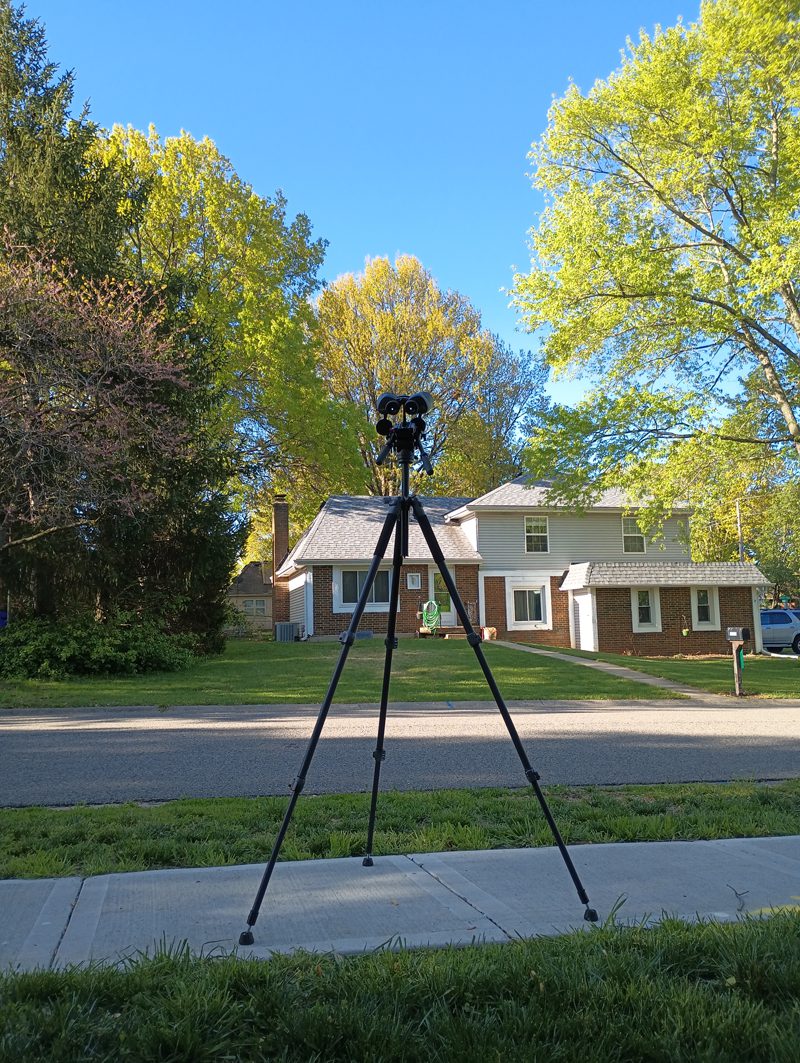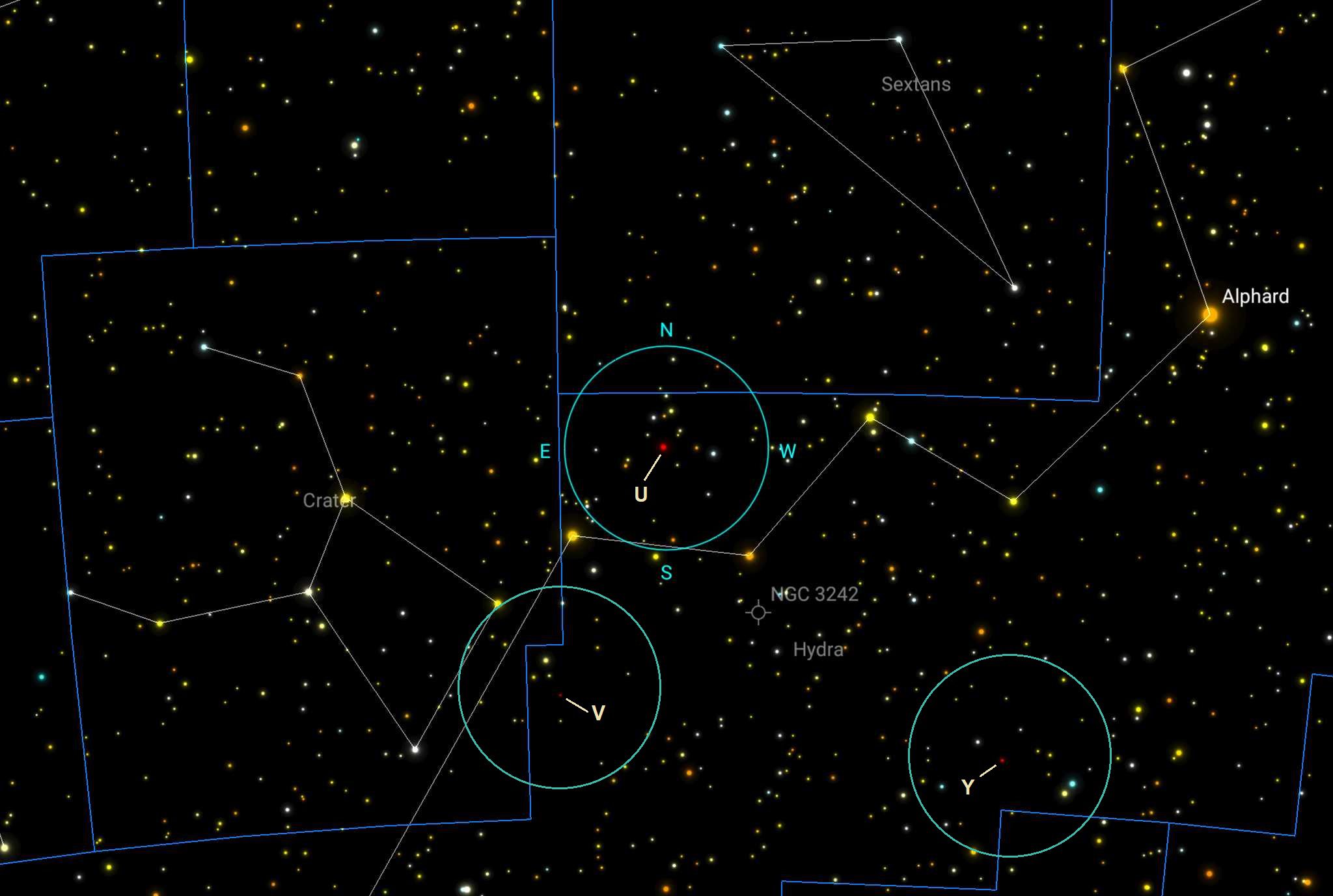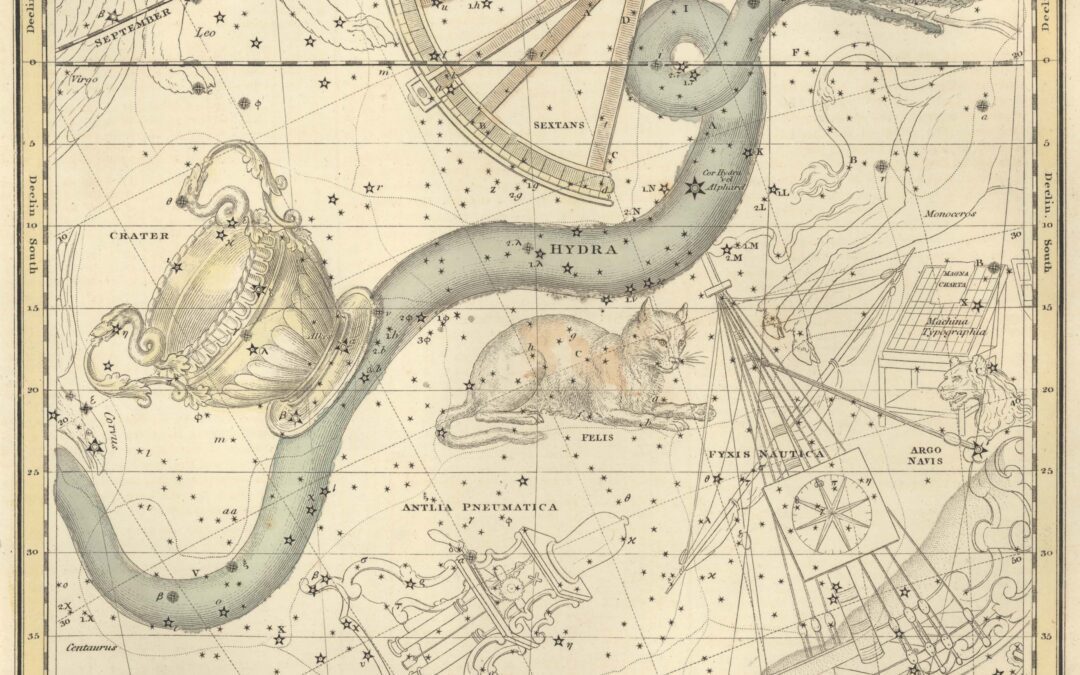Hydra is the largest constellation in the night sky (1302.84 square degrees). It can be challenging for suburban observers in mid latitudes (like Kansas 😉) because its northern border is at 7 degrees of declination, well to the south, and neighboring houses and trees obstruct the view. It’s worth the effort in the spring to get to a dark sky location with a good southern horizon to appreciate the remarkable panorama of this constellation, extending from beneath Cancer to the border of Libra near Scorpius. The above image is Plate 26 from the Celestial Atlas of Alexander Jamieson, published in 1822. Image source: Wikimedia Commons.
Hydra’s head is a striking asterism of six 3rd and 4th magnitude stars just fitting in the 6.5 degree field of a typical 10x binocular. For years I have navigated to the open cluster M67 in Cancer by working down from M44 to the north, only recently realizing it is much easier to locate it by navigating 5 degrees north from Epsilon and Zeta Hydrae in the head of Hydra.
The constellation includes four famous deep sky objects, three of which can be viewed with moderately large binoculars or with binocular telescopes in light polluted suburban skies — the open cluster M48 near the constellation’s western border, the bright Ghost of Jupiter planetary nebula (NGC 3242), and the globular cluster M68, just south of the star Kraz in the constellation Corvus. The fourth object, the galaxy M83 on the eastern side of Hydra, is difficult if not impossible to view in light polluted skies, as are many galaxies.
Double stars and bright asterisms are to be found in abundance, but Hydra also includes impressive carbon stars. Strikingly red compared to other stars, carbon stars appear in various shades of orange. I tried to observe the trio of U, V, and Y Hydrae from the east side of my yard, as the celestial water snake slithered past a notch in trees to the south. I was able to view U and V Hydra (said to be the reddest star in the sky) but Y was already too far to the west. Obstructions might seem to be a source of frustration and annoyance, but a certain amount of sport and satisfaction can be had by working around them, timing observations, and finding out what can be seen despite nearby buildings and trees.
Anyway, I decided to try again on another night, from the sidewalk north of my yard, which provides a deeper view to the south, west of the trees that foiled my first attempt at a Hydra carbon trifecta.

Shown here is my Oberwerk 10×50 Ultra on an Oberwerk 4000 tripod on the sidewalk north of my yard, which is out of view to the left in this image. A portion of the dreaded (and enormous) Pines of Roam by my driveway can be seen at the left. The OB 4000 tripod is ideal for quick astronomy forays, light enough to be carried with one hand to a convenient observing spot like this sidewalk. Where I met with success on my carbon star quest Sunday evening, 30 April 2023.

Here is a chart showing the positions of the carbon stars U, V, and Y Hydrae. The light blue circles indicate the 6.5-degree field of view provided by the 10×50 Ultra.
Most classical carbon stars are long period variables, including all three of these stars in Hydra. The stellar information below is from the AAVSO website. Distance estimates are the most recent available in simbad.
U Hydrae
Distance: 680 light years
Magnitude range: 4.7-5.2
Spectral type: C6.5,3(N2)(Tc)
Period: 389.4 days
Discoverer: Benjamin Gould (1871)
U Hydrae is easily located by triangulating from Nu and Mu Hydrae, the 3rd magnitude asterism stars (connected by the line) just to the south. It is in a pleasing 10x starfield, and appears bright orange to my eyes, without a particularly red tone. Current AAVSO estimates for U Hydrae average around 5.2 magnitude.
V Hydrae
Distance: 1412.24 light years
Magnitude range: 6.0 – 12.3 V
Spectral type: C6,3e-C7,5e(N6e)
Period: 530.7 days
Discoverer: Seth Chandler (1888)
V Hydrae can be located from a triangular asterism of three 5-7 magnitude stars in a corner of Hydra just west and south of the bright star Alkes in Corvus, which is on the edge of the second 6.5* field ring in the chart above. V Hydrae is centered in the ring. It is the reddest of these three stars, having a deep coppery orange tone. Current AAVSO estimates for V Hydrae average around 6.8 magnitude.
Y Hydrae
Distance: 1483.13 light years
Magnitude range: 6.2 – 7.4 V
Spectral type: C5,4(N3p)
Period: 154.4 d
Discoverer: Louisa Wells (1896)
Y Hydrae can be located by finding the pair of 4th magnitude stars HR 3862 and I Hydrae, which are the bright yellow and blue stars shown in the third field ring. Y Hydrae is somewhere between the color of U and V Hydrae to my eyes, deeper in tone than U but not as red as V. Current AAVSO estimates for Y Hydrae average around 7.0 magnitude.
What makes a carbon star so red? Carbon stars are older stars in which hydrogen fusion has ceased, the core has contracted and become hot enough for helium fusion to commence, which generates carbon, and the outer shell of the star has expanded and cooled. Convection can transfer carbon generated in the core to the outer shell, suppressing blue light, and causing the star to radiate red light. More information in this wikipedia article.
Numerous carbon star lists are available on the web. Two good ones are the Saguaro Astronomy Club red star database (333 stars) and the carbon star list for the Astronomical League carbon star observing program (100 stars).

